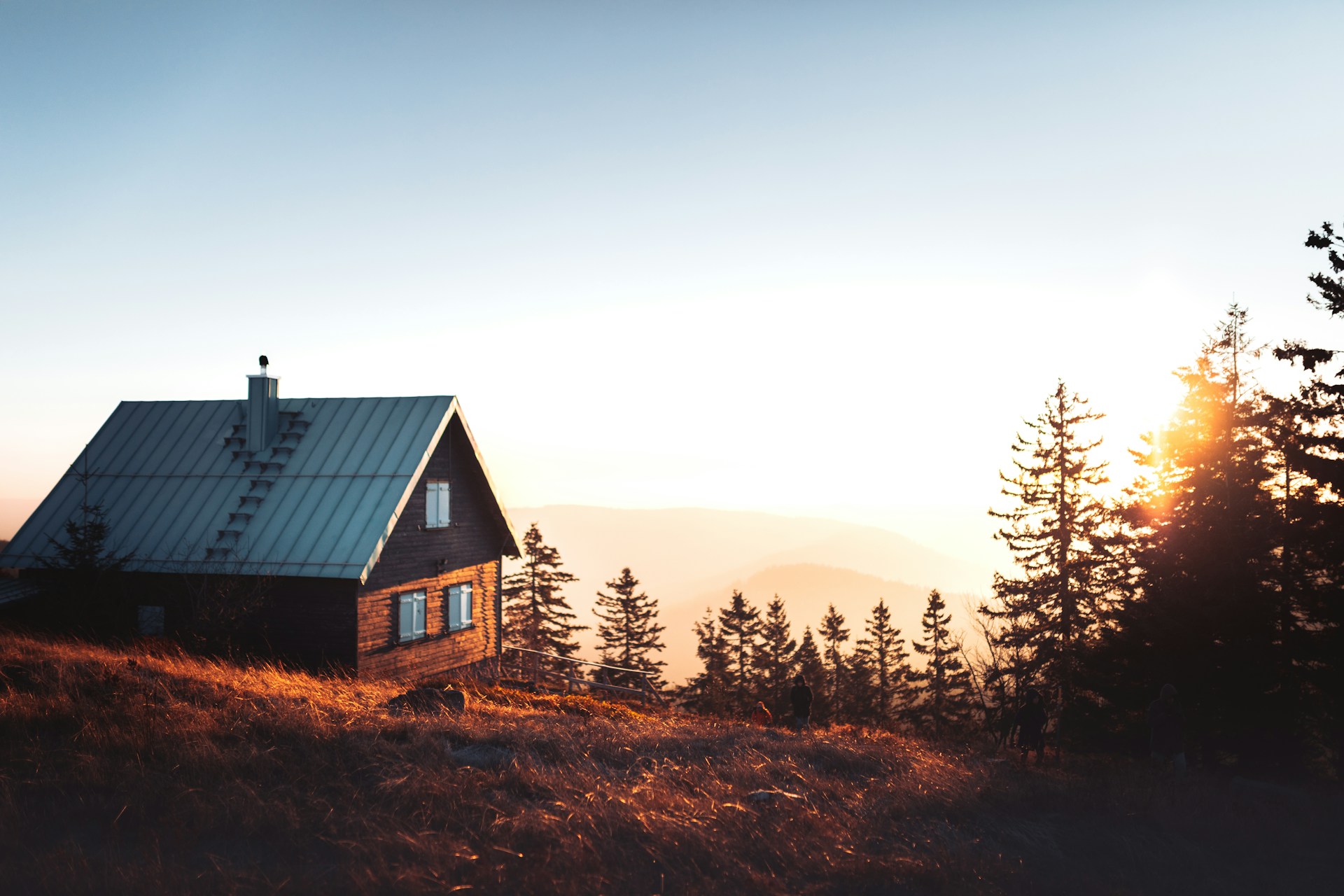
Off-grid cabin aesthetics represent a harmonious blend of functionality, sustainability, and personal expression that aligns with the natural environment. These structures are not just shelters but manifestos of a lifestyle that values self-sufficiency, minimal environmental impact, and a deep connection with nature. In this article, we will explore how off-grid cabins can achieve a balance between blending into their surroundings and expressing the owner’s personal style, all while promoting a sustainable way of living.
Cover photo by Lili Kovac
The Essence of Off-Grid Living
Off-grid living is about harnessing natural resources to meet one’s needs without relying on public utilities. This approach to living requires careful planning and consideration of the local environment. It often involves the use of solar panels, rainwater harvesting systems, composting toilets, and other sustainable technologies that reduce the carbon footprint and promote energy independence.
The Aesthetic Foundations of Off-Grid Cabins
The aesthetic of an off-grid cabin is deeply rooted in its purpose and location. The design typically reflects a minimalist philosophy, with clean lines and an open floor plan that facilitates natural light flow and ventilation. Natural materials like wood, stone, and glass are often used to create a visual and physical connection between the interior and exterior.
Blending with Nature
Site Selection. The location of an off-grid cabin is crucial for its harmony with nature. It should be chosen for its exposure to sunlight, access to water sources, soil quality, and overall natural beauty.
Design Principles. Biophilic design principles are often incorporated into off-grid cabins to enhance occupants’ connection with the natural world. Large windows, natural ventilation, and materials that age gracefully are hallmarks of this approach.
Landscaping. Landscaping with native plants not only requires less water but also supports local ecosystems and wildlife. It can also serve as a living screen or buffer between the cabin and neighboring properties, enhancing privacy while maintaining natural aesthetics.
Expressing Personal Style
While blending with nature is paramount, personal style is what makes an off-grid cabin unique to its inhabitants. This expression can be subtle, like the choice of colors and textures, or bold, such as a distinctive roofline or an artistic feature.
Here are some ways to infuse personal style into your off-grid cabin’s design
Architectural Elements
Roof Design. The roof can be both functional and stylistic. A living roof with native vegetation not only provides insulation but also creates a green landscape element. Alternatively, a metal roof with a custom pattern or color can make a statement.
Window Styles. Windows can be more than just openings for light and air; they can be focal points with unique shapes, custom finishes, or decorative hardware that reflect the owner’s taste.
Entry Features. The front door, porch design, and pathway can all be personalized to welcome guests in a way that expresses the homeowner’s personality.
Interior Design
Flooring and Walls. Choosing materials for floors and walls is an opportunity to introduce color, pattern, and texture. Reclaimed wood, locally sourced stone, or even repurposed materials can add warmth and character.
Lighting and Fixtures. Lighting choices can range from rustic lanterns to modern LED installations. Each fixture can contribute to the overall ambiance of the cabin.
Art and Decor. Personal mementos, artwork, and textiles bring life to a space. They can be a mix of contemporary pieces and vintage finds, reflecting a narrative of personal history and taste.
Sustainable Materials and Technologies
The choice of materials in an off-grid cabin extends beyond aesthetics to include sustainability and durability. Materials that are locally sourced, renewable, or recycled minimize the environmental impact and often contribute to the longevity of the structure.
Sustainable Building Materials. Wood from responsibly managed forests, bamboo, and straw bales are examples of sustainable materials. They not only reduce the carbon footprint but also can provide excellent insulation properties.
Renewable Energy Systems. Solar panels, wind turbines, and micro-hydro systems are not just functional components; they can be designed to be aesthetically pleasing and even serve as art pieces.
Water Management. Rainwater collection systems and composting toilets can be integrated into the design in a way that is both efficient and visually unobtrusive.
The Role of Technology in Achieving Balance
Technology plays a dual role in off-grid cabins: it powers the necessities while maintaining a balance with the natural setting. Advanced systems for energy storage, water purification, and waste management are essential for self-sufficiency but can be designed to have minimal visual impact.
Smart Energy Systems. Smart solar panels and battery storage systems can optimize energy use, reducing the need for additional technology while ensuring a reliable power supply.
Eco-Friendly Appliances. Compact, energy-efficient appliances are designed to fit into the cabin’s layout without compromising on functionality or style.
Integrated Systems. A seamless integration of systems like lighting, heating, and cooling can create a comfortable living environment while preserving the natural beauty of the cabin and its surroundings.
The Importance of Community and Context
Off-grid cabins are often part of a larger community or respond to their context in significant ways. Understanding the local culture, climate, and social dynamics can inform both the functional and aesthetic aspects of the design.
Community Living. In some cases, off-grid cabins are part of a planned community that values sustainability and shared resources. The collective ethos can influence the design and aesthetics of individual cabins to create a cohesive look and feel.
Cultural Sensitivity. Designing an off-grid cabin in a way that respects the local culture and traditions is crucial for creating a harmonious integration with the environment and community.
Case Studies: Off-Grid Cabins That Strike a Balance
Several notable projects around the world exemplify the successful blending of off-grid functionality with personal style and environmental aesthetics. These case studies provide inspiration and demonstrate what can be achieved through thoughtful design and sustainable practices.
The Living Cabin. A cabin in the Pacific Northwest that uses a living roof system to blend into the forested landscape while featuring reclaimed wood and large windows for panoramic views.
The Solar-Powered Retreat. Located in a desert environment, this off-grid cabin maximizes solar gain for heating and features a passive cooling design, with a minimalist aesthetic that emphasizes clean lines and natural materials.
The Modern Off-Grid Home. A contemporary off-grid home in the mountains that combines sleek, modern design with a fully sustainable infrastructure, including a rainwater harvesting system and a geothermal heating and cooling system.
Living Off-Grid: Challenges and Rewards
Living off-grid is not without its challenges. It requires a commitment to learning about and maintaining the systems that make this lifestyle possible. However, the rewards are significant, from the reduced environmental impact to the profound connection with nature and the satisfaction of self-reliance.
Lifestyle Adjustments. Living off-grid often means adapting to a slower pace of life and being mindful of resource use. It can be a transformative experience that encourages a deeper appreciation for the natural world.
Maintenance and Upkeep. The systems in an off-grid cabin require regular maintenance to ensure they function correctly. This ongoing care is part of the lifestyle choice.
Community Support. Engaging with local communities and other off-grid enthusiasts can provide support, knowledge exchange, and a sense of belonging.
Final Thoughts on Off-Grid Cabin Aesthetics
The design and aesthetics of an off-grid cabin are a reflection of the owner’s values, needs, and personal style, all while striving to create a minimal environmental footprint. The key to achieving this balance is thoughtful planning, sustainable practices, and a deep respect for the natural setting in which the cabin exists. By embracing both functionality and beauty, off-grid cabins stand as testaments to the harmony between human habitation and the natural world.
In conclusion, off-grid cabin aesthetics are about more than just visual appeal; they encompass a philosophy of living that is attuned to the rhythms of nature, responsive to individual desires, and rooted in sustainability. These cabins serve as a bridge between human needs and environmental stewardship, offering a sanctuary where one can live in harmony with the earth while expressing personal style and creativity. As we continue to face global challenges related to climate change and resource depletion, the principles that guide off-grid living may well become more mainstream, influencing how we think about design, consumption, and our place in the world.


